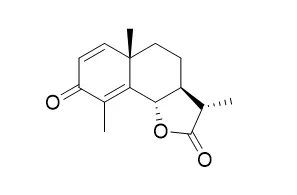| Structure Identification: |
| Acta Crystallogr Sect E Struct Rep Online. 2012 Jul 1;68(Pt 7):o2112. | | 3,5a,9-Trimethyl-8-(2-phenylhydrazin-1-ylidene)-4,5,5a,9b-tetrahydro-3aH,8H-naphtho[1,2-b]furan-2(3H)-one.[Pubmed: 22798789 ] | | The title compound, C(21)H(24)N(2)O(2), is a phenyl hydrazine derivative of the well known anthelminthic agent Alpha-Santonin, which is composed of three fused rings (benzodieneone, cyclo-hexane and γ-lactone). The cyclo-hexa-dienone ring adopts a boat conformation, the cyclo-hexane ring is in a chair conformation and the trans-fused γ-lactone ring adopts a C-envelope conformation. In the crystal, mol-ecules are linked by N-H⋯O and C-H⋯O hydrogen bonds, forming chains along the a axis. | | Z Naturforsch C. 2000 Sep-Oct;55(9-10):713-7. | | Biotransformation of two cytotoxic terpenes, alpha-santonin and sclareol by Botrytis cinerea.[Pubmed: 11098821] | Two cytotoxic terpenes, Alpha-Santonin (1) and sclareol (3) were biotransformed by a plant pathogenic fungus Botrytis cinerea to produce oxidized metabolites in high yields.
METHODS AND RESULTS:
Alpha-Santonin (1) on fermentation with the fungus for ten days afforded a hydroxylated metabolite identified as 11beta-hydroxy-Alpha-Santonin (2) in a high yield (83%), while sclareol (3) was metabolized to epoxysclareol (4) (64%) and a new compound 8-deoxy-14,15-dihydro-15-chloro-14-hydroxy-8,9-dehydrosclareol (5) (7%), representing a rare example of microbial halogenation. | | J Chromatogr. 1992 Feb 28;593(1-2):209-15. | | Use of high-performance liquid chromatographic peak deconvolution and peak labelling to identify antiparasitic components in plant extracts.[Pubmed: 1639905] | Artemisia absynthium L. is a commonly used medicinal plant for parasitic diseases all over the world.
METHODS AND RESULTS:
By means of high-performance liquid chromatography with diode-array detection and the PU6100 solvent optimization system, two sesquiterpene lactones, Alpha-Santonin and ketopelenolid-A, were tentatively identified in methanolic extracts of this plant. Alpha-Santonin is a well known antiparasitic compound and could be one of the active principles of this plant species.
CONCLUSIONS:
Reconstructed spectra are potentially useful in scanning a complex chromatogram for pharmacologically active compounds. |
|






 Cell. 2018 Jan 11;172(1-2):249-261.e12. doi: 10.1016/j.cell.2017.12.019.IF=36.216(2019)
Cell. 2018 Jan 11;172(1-2):249-261.e12. doi: 10.1016/j.cell.2017.12.019.IF=36.216(2019) Cell Metab. 2020 Mar 3;31(3):534-548.e5. doi: 10.1016/j.cmet.2020.01.002.IF=22.415(2019)
Cell Metab. 2020 Mar 3;31(3):534-548.e5. doi: 10.1016/j.cmet.2020.01.002.IF=22.415(2019) Mol Cell. 2017 Nov 16;68(4):673-685.e6. doi: 10.1016/j.molcel.2017.10.022.IF=14.548(2019)
Mol Cell. 2017 Nov 16;68(4):673-685.e6. doi: 10.1016/j.molcel.2017.10.022.IF=14.548(2019)